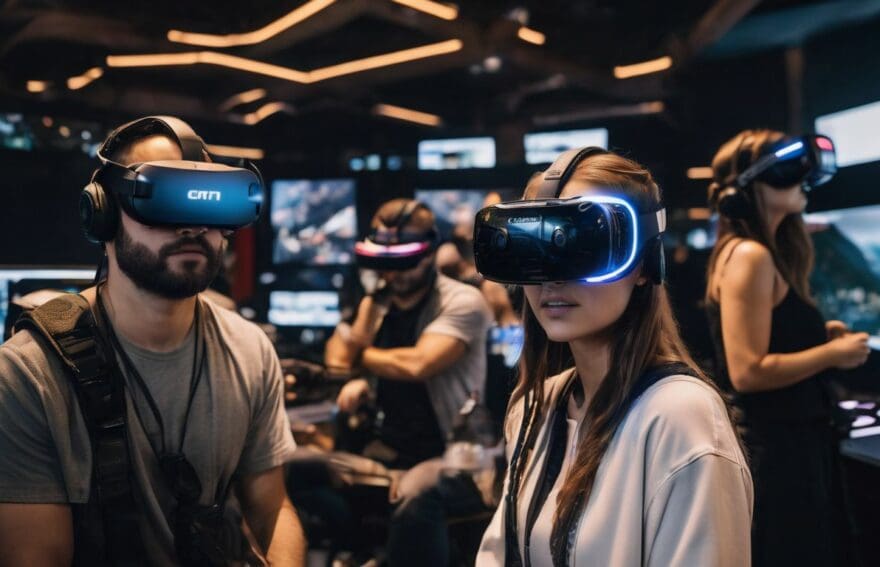The Tech Behind Esports Team Collaboration and Strategy Development

Updated On: February 28, 2024 by Aaron Connolly
In the dynamic world of esports, mastery isn’t solely down to talent; it’s about harnessing cutting-edge technology as well. We can relate to those challenges faced on our digital battlegrounds, especially with augmented and virtual reality technologies poised to revolutionise our experiences, soaring towards an astonishing $72.8 billion in revenue by 2023.
Within this piece, we’ll delve into the pioneering tech that reshapes the way teams unite and strategise, offering you a privileged glimpse behind the scenes. Brace yourself for an enthralling voyage into the high-tech heart of competitive gaming!
Key Takeaways
- Esports technology is crucial in developing team strategies, with advancements like AI and VR enhancing player communication and gameplay.
- High – quality gaming equipment and robust infrastructure are essential for esports teams to perform at their best during training and tournaments.
- Mobile gaming’s surge has opened up esports to a wider audience, allowing gamers to play competitively from anywhere at any time.
- Virtual reality is shaping the future of esports by providing immersive experiences that improve team dynamics and attract more investments.
- The global impact of esports continues to grow, with revenue projections showing significant returns, creating numerous opportunities for careers within the industry.
Evolution of Esports Technology
The evolution of esports technology has been driven by the increasing demand for high-quality gaming equipment and infrastructure. As competitive gaming continues to grow, so does the need for innovations in game design, virtual reality (VR), mobile gaming, cloud gaming, and artificial intelligence (AI).
These advancements have not only transformed the way games are played but also how teams collaborate and develop their strategies.
Gaming Equipment
We can’t ignore the impact of high-quality gaming hardware on our performance and overall gaming experience. It’s vital we invest in top-tier keyboards, mice, monitors, and headsets that offer us the precision and speed needed to stay competitive.
Our gear must keep up with intense training schedules and withstand hours of rigorous gameplay. We also look for customisation options in equipment that allow us to tweak settings perfectly aligned with our individual playstyles.
Advanced gaming rigs have become an essential part of esports, pushing boundaries with powerful processors and graphics cards designed specifically for the demands of professional gaming.
To meet audience expectations for crystal-clear streams and flawless gameplay during tournaments, it’s crucial our machines pack a punch in terms of processing power and display technology.
And as we collaborate with tech giants for cutting-edge developments, we’re always on the lookout for innovations that can give us an edge over the competition while enhancing spectator engagement – after all, winning is important but so is putting on a great show!
Infrastructure
Building on the importance of having cutting-edge gaming equipment, the infrastructure plays a crucial role in providing a seamless and high-quality experience for esports team collaboration and strategy development.
From robust internet connectivity to advanced server systems, an efficient infrastructure is essential for ensuring smooth communication, data transfer, and real-time interaction among players and teams.
With the rapid advancements in technology, infrastructure elements such as cloud computing and high-speed networks are becoming increasingly vital for creating an environment where gamers can collaborate effectively regardless of their physical locations.
To support the complex demands of modern competitive gaming, secure and reliable infrastructure is necessary to facilitate smooth gameplay, strategic planning discussions, and seamless execution of game tactics.
Innovations in Game Design and Technology
Game design and technology have evolved to include virtual reality (VR), mobile gaming, cloud gaming, and artificial intelligence (AI). These innovations have revolutionised the esports industry, providing a more immersive and dynamic experience for both players and spectators alike.
Virtual Reality (VR)
Virtual Reality (VR) technology has significantly impacted the esports industry, offering immersive and engaging experiences for both players and spectators. With a projected combined revenue of $72.8 billion by 2023, AR and VR technologies are revolutionising the gaming landscape.
The use of VR in competitive gaming enhances teamwork, communication, and overall team dynamics, providing an unparalleled level of involvement for gamers. Additionally, VR advancements have led to innovative strategies in game design, creating new opportunities for audience engagement and sponsorships within the competitive gaming industry.
Furthermore, the integration of VR technology has expanded investment opportunities in video gaming while paving the way for unprecedented partnerships and entertainment experiences.
Mobile Gaming
Mobile gaming has revolutionised the gaming landscape, providing accessibility and convenience to gamers of all levels. With the advancement of mobile technology, gamers can now enjoy high-quality graphics and engaging gameplay experiences on their smartphones or tablets.
This innovation has opened up new possibilities for esports, allowing players to compete in tournaments and collaborate with teammates anytime and anywhere. According to industry reports, revenue from mobile gaming is projected to reach $100 billion by 2021, indicating the significant impact of this platform on the gaming industry.
Esports enthusiasts can take advantage of mobile gaming platforms to hone their skills, connect with other players, and participate in competitive events. Due to its widespread availability and user-friendly interfaces, mobile gaming presents a unique opportunity for novice gamers to enter the esports arena and engage in strategic gameplay development.
Cloud Gaming
Cloud gaming is revolutionising the way gamers access and play their favourite titles. This technology allows players to stream games directly from remote servers, eliminating the need for high-end hardware and storage space.
With cloud gaming, gamers can enjoy a vast library of titles on various devices, including smartphones, tablets, and low-spec PCs. This accessibility not only expands the reach of gaming but also opens up new opportunities for esports competitions and collaborations.
As cloud gaming continues to evolve and gain traction in the industry, it presents an exciting prospect for both passionate and novice gamers.
The future of cloud gaming holds promise as advancements in streaming technology make it possible to deliver high-quality gameplay experiences with minimal latency – paving the way for more widespread adoption among esports enthusiasts looking to engage with their favourite titles seamlessly.
Artificial Intelligence (AI)
Artificial Intelligence (AI) is revolutionising the world of esports by enhancing game experiences and strategy development. AI-powered tools are being incorporated into gaming platforms to analyse player data and provide valuable insights for team collaboration and performance improvement.
With a projected revenue of $72.8 billion by 2023, AR and VR technologies show immense potential in shaping the future of competitive gaming.
Esports enthusiasts can benefit from AI-driven analytics that offer detailed performance metrics, helping players refine their gameplay tactics and strategies. This technology also supports teams in identifying strengths and weaknesses, enabling them to develop more effective collaborative approaches.
Immersive Esports Visualisation
The Evolution of Visualisation has transformed the way gamers experience Esports, offering a more immersive and engaging environment for competitive play. Read on to discover the advantages of Immersive Visualisation in Esports team collaboration and strategy development.
The Evolution of Visualisation
Esports visualisation has evolved significantly, with advancements in technology enhancing the immersive experience for gamers. High-definition graphics and 3D rendering have revolutionised visualisation, creating realistic environments that enhance gameplay.
This evolution has not only increased the appeal of esports to a wider audience but has also elevated the overall gaming experience, drawing in more investment and sponsorship opportunities, thus contributing to the exponential growth of the industry.
These technological advancements have allowed for more sophisticated game design and development, providing gamers with visually stimulating experiences that blur the lines between virtual and real-world environments.
Advantages of Immersive Visualisation
Immersive visualisation offers a realistic and interactive experience, allowing gamers to feel fully immersed in the virtual world. This technology enhances player engagement by providing a more captivating and intense gaming environment.
It also allows for better spatial awareness, enabling players to make quicker and more accurate decisions during gameplay. With AR and VR technologies projected to generate a combined revenue of $72.8 billion by 2023, immersive visualisation presents lucrative opportunities for players, developers, and investors alike.
Furthermore, immersive visualisation can significantly impact esports partnerships and sponsorship opportunities. Marketers can leverage this technology to create unique advertising experiences within games, enhancing brand visibility while offering gamers an enhanced overall experience.
Statistics
Having explored the advantages of immersive visualisation, we now delve into the significant numbers that illuminate the growth and impact of technology in the esports industry. Data speaks volumes, and here, statistics offer a clear view of the technological evolution powering competitive gaming.
| Statistic | Detail |
|---|---|
| AR and VR Revenue Projection | $72.8 billion by 2023 |
| Esports Global Audience | Engaged and demographics-specific, with interactive opportunities |
| Esports Industry Drivers | Competitive gaming popularity, tech advancements, online platforms |
| Esports Talent Nurturing | Federations developing programs supporting athlete careers |
| Esports Ecosystem Parties | Players, developers, sponsors, franchises, and tech companies |
| Franchise Longevity | Establishing validity and success for sustained growth |
| Innovation Collaboration | Gaming and tech giants working together on hardware and software |
| Esports Sponsorship Format | PDF proposals used to secure event sponsorships |
| Esports Market Value | Significant with potential for further growth and impact |
| Esports vs Traditional Sports | Comparisons made due to explosive growth and entertainment influence |
These statistics showcase the trajectory and future potential of esports. They reflect our passion for an industry where technology not only enhances player experience but also shapes the cultural landscape of gaming and entertainment.
The Rise of Esports
Esports has seen a meteoric rise in popularity over the past decade, with millions of viewers tuning in to watch live gaming competitions. The global impact of esports has led to increased investment, sponsorships, and the development of advanced communications technology for players and teams.
Understanding Esports
Esports is a rapidly growing industry that revolves around competitive video gaming. Players from around the world participate in organised, multiplayer competitions across various game genres, such as first-person shooters, real-time strategy games, and multiplayer online battle arenas.
The global audience for esports has surged in recent years due to the increased accessibility of online platforms and the rise of professional gaming leagues. Esports offers a platform for gamers to showcase their skills and expertise while engaging with a diverse community of like-minded individuals.
Players involved in esports often dedicate extensive hours to honing their abilities through rigorous training regimens and strategic gameplay. As technology continues to evolve, so do the opportunities within esports – from career prospects for content creators to sponsorship opportunities for organisations looking to tap into this flourishing market space.
The growth of esports has had a profound impact on the broader entertainment industry, attracting investments and partnerships from major companies eager to be part of its expanding influence.
Global Impact
Esports has made a significant global impact, with revenue projections reaching billions of dollars by 2023. Marketers are flocking to esports for the engaged audience and interactive engagement opportunities it offers.
This growth is driven by the increasing popularity of competitive gaming, advancements in gaming technology, and the expansion of online platforms. Esports federations are fostering talent and helping athletes pursue careers in competitive gaming, creating numerous sponsorship opportunities for companies looking to invest in this booming industry.
Furthermore, the explosive growth of esports is not only being felt within the sports industry but also impacting traditional entertainment media. The comparison between esports and traditional sports continues as its influence expands further into various sectors.
With such potential for future growth and impact on different industries, it’s clear that esports will continue to thrive globally.
Communications Technology
With the global impact of esports continuing to expand, communications technology plays a crucial role in shaping the industry. From live streaming platforms to voice communication software, it has revolutionised how players interact and strategise within a team.
Esports sponsorship opportunities have also been greatly enhanced through targeted marketing campaigns using social media channels such as Twitter, Instagram, and Facebook to engage with fans and potential sponsors.
Furthermore, advancements in online gaming have led to seamless connectivity and real-time interactions among gamers across the globe, contributing significantly to the growth and influence of competitive gaming.
The explosive growth of esports has transformed communications technology into an indispensable tool for collaboration and strategy development among teams. Emerging technologies such as virtual reality (VR) headsets enable players to immerse themselves in a simulated environment, fostering teamwork and tactical planning like never before.
Technology in Esports
The importance of technology in esports cannot be overstated. It has opened up career opportunities for content creators, created a professional gaming industry, and had a significant impact on media.
Fair play and regulations are also being heavily influenced by advancements in technology.
Importance of Technology
Technology plays a crucial role in driving the success and advancement of esports. Cutting-edge gaming equipment, innovative game design, and immersive visualisation technologies have revolutionised the way gamers collaborate and develop strategies.
The integration of artificial intelligence (AI), virtual reality (VR), and mobile gaming has enhanced the competitive landscape within esports. These advancements not only provide a more engaging experience for players but also attract a wider audience, contributing to the exponential growth of the industry.
Esports technology has also opened up new career opportunities for content creators and professional gamers, creating avenues for interactive engagement with fans through media platforms.
Career Opportunities for Content Creators
Content creators in the esports industry have diverse career opportunities, ranging from video production and livestreaming to social media management and graphic design. With the explosive growth of esports, there is a rising demand for engaging content that captures the excitement of competitive gaming and keeps a global audience connected.
Skilled content creators can leverage their talents to work with professional esports teams, gaming companies, and event organisers to produce captivating visual storytelling that amplifies the thrill of virtual battles.
These professionals play an integral role in enhancing fan engagement, expanding brand reach, and driving revenue through innovative content strategies.
As the esports landscape continues to evolve, content creators have an opportunity to shape narratives around players’ journeys, highlight cutting-edge technologies, and contribute to the immersive experience for fans.
They can also explore avenues such as creating educational content about game strategies or producing entertaining vlogs that offer behind-the-scenes glimpses into the world of competitive gaming.
Professional Gaming
Esports has paved the way for professional gaming, offering opportunities for skilled gamers to compete at the highest level. The growth of the esports industry has led to lucrative career paths for players, with major competitions offering substantial prize pools.
Esports federations and organisations are increasingly investing in nurturing talent and facilitating sustainable careers in competitive gaming, highlighting that professional gaming is more than just a hobby or pastime.
The rise of professional gaming has also attracted significant investment from sponsors and technology companies, providing players with access to cutting-edge equipment and infrastructure.
This investment extends beyond hardware and software development, as marketers leverage the engaged audience of esports events to target specific demographics through interactive engagement opportunities.
Impact on Media
Esports has had a significant impact on media, with live streaming platforms like Twitch and YouTube attracting millions of viewers to watch competitive gaming events. This surge in viewership has led traditional media outlets to take notice, integrating esports coverage into their programming.
Marketers also recognise the potential of esports as an advertising platform, tapping into the engaged audience and targeting specific demographics for interactive engagement opportunities.
Furthermore, the growth of esports has brought about collaborations between gaming companies and tech giants to develop cutting-edge hardware and software. These advancements have not only enhanced the gaming experience but have also created innovative avenues for technology within the media industry.
As a result, we witness an evolution in how media portrays and engages with competitive gaming events, blurring the lines between traditional sports coverage and digital entertainment.
Fair Play and Regulations
Moving from the impact of technology on media to the critical aspect of fair play and regulations in esports, it is essential to maintain integrity and uphold sportsmanship within the gaming community.
The fair play rules are designed to ensure that all players compete on a level playing field, free from any unfair advantage. Regulations also cover issues such as player conduct, anti-cheating measures, and drug testing to maintain the ethical standards of competitive gaming.
Esports federations are actively working with government bodies worldwide to establish clear guidelines for fair play and create an environment conducive to healthy competition.
As part of these efforts, industry leaders have introduced codes of conduct and set up governing bodies dedicated to maintaining fairness and transparency in esports competitions. Additionally, regulations aim to protect both players and spectators by ensuring a safe and inclusive environment for everyone involved in the gaming ecosystem.
Conclusion
In conclusion, the tech behind esports team collaboration and strategy development plays a vital role in shaping the future of competitive gaming. Innovations in game design, infrastructure, and communications technology have transformed esports into a global phenomenon.
With ongoing advancements in AR, VR, and AI technologies, the potential for growth and impact on revenue within the industry is substantial. The collaborative efforts of gaming companies and tech giants continue to drive innovation, creating new opportunities for content creators and professional gamers alike.
FAQs
1. What tech is used for esports team collaboration?
Esports teams use advanced software and communication tools to work together and develop strategies, ensuring they perform at their best during competitive gaming.
2. How has the evolution of competitive gaming impacted team strategy development?
The rapid evolution of competitive gaming has pushed teams to adopt sophisticated analytics and video review technologies to refine strategies and gain a competitive edge.
3. Can investment in video gaming technology improve an esports team’s performance?
Investing in cutting-edge video gaming technology can significantly enhance an esports team’s training methods, collaboration efficiency, and overall strategic development.
4. Why is good collaboration important in esports?
Strong collaboration allows esports players to coordinate better, make quick decisions, and execute complex game plans effectively, which is crucial for success in high-stakes tournaments.
















